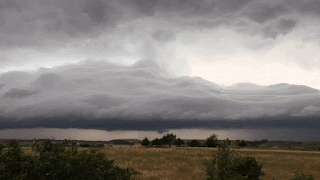ProfessorRoush thought he'd attempt a wee little blogging experiment today and, at the same time, try to bring you a small glimpse of the fury of a Flint Hill's storm. He has long wanted to include movies in the blog and it occurred to me that conversion to animated GIF's might work. I apologize in advance if the files are a little big for slow Internet connections.
On 5/18/2017, there were severe thunderstorm warnings in the area, and sure enough, in the early evening the sirens started to blast and the Thursday night TV lineups were interrupted for continuous local weather coverage. A Tornado Warning was posted directly for western Manhattan, and we began watching out the windows. While taking the photo of the ominous cloud at the left, I suddenly discovered that in one of the recent iPhone upgrades, there was a new photo option for time-lapse video.
 Modern technology is absolutely incredible, isn't it? Who would have thought, 40 years ago at the beginning of the computer age, that a slim device in my pocket would become more versatile than any camera in existence at that time, would replace our entire stacks of records and tapes, would carry all our databases and records, and would manage all our communications in ways that we could never have imagined? Each of these videos captures between 1 and 2 minutes of actual time, a time span roughly equivalent to my attention span and ability to hold the camera still with only moderate fidgeting. Make sure you click on the pictures to view them in full size and majesty.
Modern technology is absolutely incredible, isn't it? Who would have thought, 40 years ago at the beginning of the computer age, that a slim device in my pocket would become more versatile than any camera in existence at that time, would replace our entire stacks of records and tapes, would carry all our databases and records, and would manage all our communications in ways that we could never have imagined? Each of these videos captures between 1 and 2 minutes of actual time, a time span roughly equivalent to my attention span and ability to hold the camera still with only moderate fidgeting. Make sure you click on the pictures to view them in full size and majesty.Setting aside my awe and wonder for technology, and moving on to my awe and wonder for Mother Nature, from our high vantage point northwest of Manhattan, we expected at any moment to see a long finger extend from the cloud to touch the earth, but it never materialized and Manhattan, and we, were safe. When the rain and wind finally hit us, my garden took a little beating, but it too, withstood the test of climate with little damage. ProfessorRoush was left only with the memories and a newfound magic ability to add to his photographic repertoire.
There's a second part of the experiment of course. I was going to put the still photo on this entry first, but then thought, "Hey, who not lead off with a video?" Besides learning if the videos would play in the blog, I also wanted to see what happens to the "preview" image created when some of you link my blog to yours. Will it show motion as well?
(Postscript addition; The "preview images" in links in other blogs DO show motion. Yay!)
















